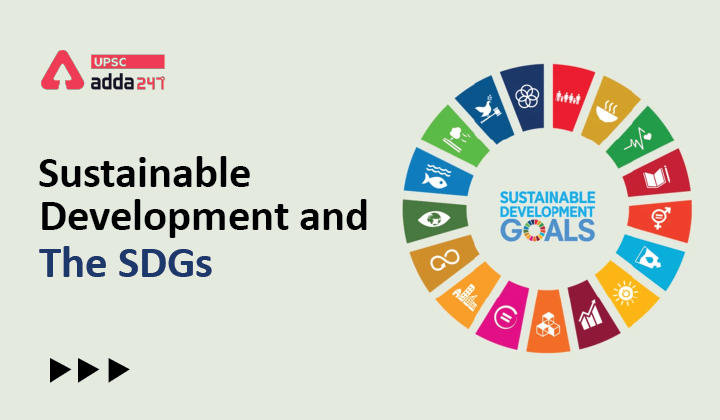Table of Contents
Sustainable Development Goals: Relevance
- GS 3: Conservation, environmental pollution and degradation, environmental impact assessment.
This will be a 2-article series. In the previous article, we discussed the concept of sustainable development and its evolution. In this article, we will discuss all the UN sustainable development goals and their respective targets. . Both the articles are very important for all the phases of UPSC CSE 2022— prelims, mains and interview.
What are Sustainable Development Goals?
- First discussed in United Nations Conference on Sustainable Development in Rio de Janeiro in 2012, the Sustainable Development Goals (SDGs), also known as the Global Goals, were adopted by all United Nations Member States in 2015.
- Sustainable development goals of UN were adopted as a universal call to action to end poverty, protect the planet and ensure that all people enjoy peace and prosperity by 2030.
- In 2015, 3-landmark agreement was signed. Sustainable development goals by UN , COP 15 or Paris Climate Conference and Sendai Framework for Disaster Risk Reduction.
UNDP role
- As the lead UN development agency, UNDP is well-placed to help implement the Goals in some 170 countries and territories.
SDG background
- The sustainable development goals by UNDP replaced the Millennium Development Goals (MDGs), which started a global effort in 2000 to tackle the indignity of poverty.
- For 15 years, the MDGs drove progress in several important areas. Following are its few achievements.
MDG achievements
- More than 1 billion people have been lifted out of extreme poverty (since 1990)
- Child mortality dropped by more than half (since 1990)
- The number of out of school children has dropped by more than half (since 1990)
- HIV/AIDS infections fell by almost 40 percent (since 2000)
Sustainable Development Goals: UN SDG Goals
- There are 17 sustainable development goals , 169 targets and 247 indicators.
SDG 1: End poverty in all its forms everywhere
Important targets:
- By 2030, eradicate extreme poverty for all people everywhere, currently measured as people living on less than $1.25 a day.
- By 2030, reduce at least by half the proportion of men, women and children of all ages living in poverty in all its dimensions according to national definitions.
- By 2030, ensure that all men and women, in particular the poor and the vulnerable, have equal rights to economic resources, as well as access to basic services.
- By 2030, build the resilience of the poor and those in vulnerable situations and reduce their exposure and vulnerability to climate-related extreme events and other economic, social and environmental shocks and disasters.
SDG 2: End hunger, achieve food security and improved nutrition and promote sustainable agriculture
Important targets
- By 2030, end hunger and ensure access by all people, in particular the poor and people in vulnerable situations, including infants, to safe, nutritious and sufficient food all year round.
- By 2030, end all forms of malnutrition, including achieving, by 2025, the internationally agreed targets on stunting and wasting in children under 5 years of age, and address the nutritional needs of adolescent girls, pregnant and lactating women and older persons.
- By 2030, double the agricultural productivity and incomes of small-scale food producers.
SDG 3: Ensure healthy lives and promote well-being for all at all ages
Important targets
- By 2030, reduce the global maternal mortality ratio to less than 70 per 100,000 live births.
- By 2030, end preventable deaths of new-borns and children under 5 years of age, with all countries aiming to reduce neonatal mortality to at least as low as 12 per 1,000 live births and under-5 mortality to at least as low as 25 per 1,000 live births.
- By 2030, end the epidemics of AIDS, tuberculosis, malaria and neglected tropical diseases and combat hepatitis, water-borne diseases and other communicable diseases.
- By 2030, reduce by one third premature mortality from non-communicable diseases through prevention and treatment and promote mental health and well-being.
- By 2020, halve the number of global deaths and injuries from road traffic accidents.
- Achieve universal health coverage, including financial risk protection, access to quality essential health-care services and access to safe, effective, quality and affordable essential medicines and vaccines for all.
- By 2030, substantially reduce the number of deaths and illnesses from hazardous chemicals and air, water and soil pollution and contamination.
SDG 4: Ensure inclusive and equitable quality education and promote lifelong learning opportunities for all.
Important Targets
- By 2030, ensure that all girls and boys complete free, equitable and quality primary and secondary education leading to relevant and effective learning outcomes.
- By 2030, ensure that all girls and boys have access to quality early childhood development, care and pre-primary education so that they are ready for primary education.
- By 2030, ensure equal access for all women and men to affordable and quality technical, vocational and tertiary education, including university.
- By 2030, eliminate gender disparities in education and ensure equal access to all levels of education and vocational training.
SDG 5: Achieve gender equality and empower all women and girls
Important targets
- End all forms of discrimination against all women and girls everywhere.
- Eliminate all forms of violence against all women and girls in the public and private spheres, including trafficking and sexual and other types of exploitation.
- Eliminate all harmful practices, such as child, early and forced marriage.
- Recognize and value unpaid care and domestic work through the provision of public services, infrastructure and social protection policies.
SDG 6: Ensure availability and sustainable management of water and sanitation for all
Important targets
- By 2030, achieve universal and equitable access to safe and affordable drinking water for all.
- By 2030, achieve access to adequate and equitable sanitation and hygiene for all and end open defecation, paying special attention to the needs of women and girls and those in vulnerable situations.
- By 2030, improve water quality by reducing pollution, eliminating dumping and minimizing release of hazardous chemicals and materials, halving the proportion of untreated wastewater and substantially increasing recycling and safe reuse globally.
- By 2030, substantially increase water-use efficiency across all sectors and ensure sustainable withdrawals and supply of freshwater to address water scarcity and substantially reduce the number of people suffering from water scarcity.
SDG 7: Ensure access to affordable, reliable, sustainable and modern energy for all
Important targets
- By 2030, ensure universal access to affordable, reliable and modern energy services.
- By 2030, increase substantially the share of renewable energy in the global energy mix.
- By 2030, double the global rate of improvement in energy efficiency.
SDG 8: Promote sustained, inclusive and sustainable economic growth, full and productive employment and decent work for all
Important targets
- Sustain per capita economic growth in accordance with national circumstances and, in particular, at least 7 per cent gross domestic product growth per annum in the least developed countries.
- By 2030, achieve full and productive employment and decent work for all women and men, including for young people and persons with disabilities, and equal pay for work of equal value.
- Take immediate and effective measures to eradicate forced labour, end modern slavery and human trafficking and secure the prohibition and elimination of the worst forms of child labour, including recruitment and use of child soldiers, and by 2025 end child labour in all its forms.
- By 2030, devise and implement policies to promote sustainable tourism that creates jobs and promotes local culture and products.
SDG 9: Build resilient infrastructure, promote inclusive and sustainable industrialization and foster innovation
Important targets
- Promote inclusive and sustainable industrialization and, by 2030, significantly raise industry’s share of employment and gross domestic product, in line with national circumstances, and double its share in least developed countries.
SDG 10: Reduce inequality within and among countries
Important targets
- By 2030, progressively achieve and sustain income growth of the bottom 40 per cent of the population at a rate higher than the national average.
- By 2030, empower and promote the social, economic and political inclusion of all, irrespective of age, sex, disability, race, ethnicity, origin, religion or economic or other status.
SDG 11: Make cities and human settlements inclusive, safe, resilient and sustainable
Important targets
- By 2030, ensure access for all to adequate, safe and affordable housing and basic services and upgrade slums.
- By 2030, enhance inclusive and sustainable urbanization and capacity for participatory, integrated and sustainable human settlement planning and management in all countries.
- By 2030, reduce the adverse per capita environmental impact of cities, including by paying special attention to air quality and municipal and other waste management.
SDG 12: Ensure sustainable consumption and production patterns
Important targets
- Implement the 10-year framework of programmes on sustainable consumption and production, all countries taking action, with developed countries taking the lead, taking into account the development and capabilities of developing countries.
- By 2030, halve per capita global food waste at the retail and consumer levels and reduce food losses along production and supply chains, including post-harvest losses.
SDG 13: Take urgent action to combat climate change and its impacts
Important targets
- Strengthen resilience and adaptive capacity to climate-related hazards and natural disasters in all countries.
- Implement the commitment undertaken by developed-country parties to the United Nations Framework Convention on Climate Change to a goal of mobilizing jointly $100 billion annually by 2020 from all sources to address the needs of developing countries.
SDG 14: Conserve and sustainably use the oceans, seas and marine resources for sustainable development
Important targets
- By 2025, prevent and significantly reduce marine pollution of all kinds, in particular from land-based activities, including marine debris and nutrient pollution.
- By 2020, conserve at least 10 per cent of coastal and marine areas, consistent with national and international law and based on the best available scientific information.
- By 2020, effectively regulate harvesting and end overfishing, illegal, unreported and unregulated fishing and destructive fishing practices and implement science-based management plans, in order to restore fish stocks in the shortest time feasible, at least to levels that can produce maximum sustainable yield as determined by their biological characteristics.
SDG 15: Protect, restore and promote sustainable use of terrestrial ecosystems.
Important targets
- By 2030, combat desertification, restore degraded land and soil, including land affected by desertification, drought and floods, and strive to achieve a land degradation-neutral world.
- By 2030, ensure the conservation of mountain ecosystems, including their biodiversity, in order to enhance their capacity to provide benefits that are essential for sustainable development.
- By 2020, ensure the conservation, restoration and sustainable use of terrestrial and inland freshwater ecosystems and their services.
SDG 16: Promote peaceful and inclusive societies for sustainable development, provide access to justice for all and build effective, accountable and inclusive institutions at all levels
Important targets
- Significantly reduce all forms of violence and related death rates everywhere.
- End abuse, exploitation, trafficking and all forms of violence against and torture of children.
- By 2030, significantly reduce illicit financial and arms flows, strengthen the recovery and return of stolen assets and combat all forms of organized crime.
SDG 17: Strengthen the means of implementation and revitalize the global partnership for sustainable development
Important targets
- Strengthen domestic resource mobilization, including through international support to developing countries, to improve domestic capacity for tax and other revenue collection.
- Assist developing countries in attaining long-term debt sustainability through coordinated policies aimed at fostering debt financing, debt relief and debt restructuring, as appropriate, and address the external debt of highly indebted poor countries to reduce debt distress.
Also Read:
| Women in STEM | SPIN scheme | Shoonya Campaign | Arsenic Found in Wheat, Potato in Rural Bihar |
| Reforms in Urban Planning Capacity in India | Trade and Development Report 2021 | Trade and Development Report 2021 | Euro Green Bond |
| The History of Backward Classes Commission And the Sub-Categorisation of OBCs | Elderly Population Of India: Expert Committee On Longevity Finance | Impact of US Inflation in India | Pradhan Mantri Awas Yojana- Gramin |
| India Rejects WTO Draft on Fishery Subsidy | Supreme Court Allows Legal Sand Mining in Rajasthan | ADR Report on Political Donations | Delhi Declaration on Afghanistan |





 TSPSC Group 1 Question Paper 2024, Downl...
TSPSC Group 1 Question Paper 2024, Downl...
 TSPSC Group 1 Answer key 2024 Out, Downl...
TSPSC Group 1 Answer key 2024 Out, Downl...
 UPSC Prelims 2024 Question Paper, Downlo...
UPSC Prelims 2024 Question Paper, Downlo...
